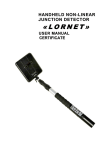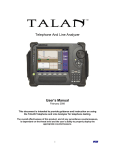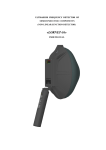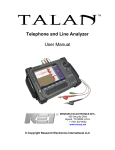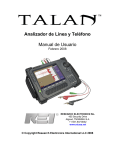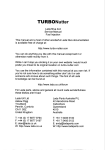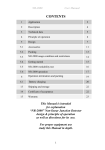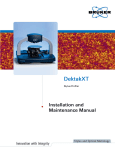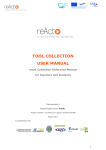Download Lornet-24 EN Manual - WOSTIMEX Export/Import GmbH
Transcript
ULTRA-COMPACT HANDHELD NON-LINEAR JUNCTION DETECTOR «LORNET-24» U S E R M AN U AL CERTIFICATE 2 U S E R M AN U AL 1. Introduction The ultra-compact non-linear junction detector “LORNET-24” (further NLJD) is used for search and location of electronic devices both in active and switch-off state. The detector operation is based on the property of semiconductor components to generate a response at the 2nd and 3rd harmonics when radiated by an UHF probing signal. Semiconductor components of artificial origin will have a higher level second harmonic while semiconductor components of natural origin (e.g. oxide films) will have a higher level third harmonic respectively. An NLJD analyzes the 2nd and 3rd harmonics response of the radiated objects, which enables a quick and reliable identification of electronic devices and natural oxide semiconductors. The NLJD “LORNET-24” automatically finds the best receiving frequency channel free of noise and distortion providing flawless operation even in the complicated electromagnetic environment. The frequency tuning algorithm implemented in “LORNET-24” automatically selects the probing signal frequency such that the noise level in the 2nd harmonic receiving channel is held minimal, while digital processing of a demodulated signal gives maximum sensitivity. There are two types of radiated signals: - continuous wave carrier (CW); - pulse modulated carrier with a duty cycle 44 (pulse). This enables to combine wide detection range and reliable identification of the devices found. The output power automatic control mode significantly simplifies operator’s work. “LORNET-24” simultaneously displays the 2nd and 3rd harmonics levels at its LED panel. Besides, the 2nd and 3rd harmonics levels can be estimated in turn aurally by the click repetition rate reproduced through a built-in loudspeaker or wireless earphones. Detector of the returned UHF signal envelope enables tapping radio microphones and using the acoustic feedback mode which facilitates search work. 2. Specifications: 2.1. Radiated signal types: - continuous wave carrier; - pulse modulated carrier with a duty cycle 44. 2.2. Carrier frequency step 2MHz within a tuning range of (2406 … 2414) MHz. Automatic frequency selection. Possibility of radiation at the carrier frequency with a minimum noise level in the 2nd harmonic receiver path. 2.3. Maximum radiated power in the CW mode ≥0.3W 2.4. Peak radiated power in the pulse mode ≥10W. 2.5. Manual or automatic control of the radiated power level. Dynamic control range of 20dB down from the maximum output power value with 11 level gradations. 2.6. Receivers sensitivity better than –110dBm (one LED lights up at the indicator scale). 2.7. Receivers tuning frequencies equal to the transmitter double and triple frequencies. 2.8. Receiving path dynamic range ≥ 20 dB (10dB – LED indicator range, 10dB – attenuator adjusting range at receivers input). 2.9. Time of continuous operation with a lithium-Ion battery at the maximum radiated power: 3 - ≥3 hours in the pulse mode; - ≥1.5 hours in the CW mode. 2.10. Unlimited operation time from 220 V mains with charger (CH1) connected. 2.11. Equipped device weight ≤0.65kg. 2.12. Operating conditions: - ambient temperature 5…40°C. - pressure ≥ 450mm of mercury 3. Delivery Set, design and Accessories 3.1. The device includes units and accessories stated in the Table below: No. 1. 2. 3. 4. 5. Description A duplex antenna unit with a built-in battery A charger for a duplex unit (CH1) Wireless phones including: head phones, a receiver and a charger (CH2) User Manual, Certificate A package bag to keep and transport the device 1 2 Q-ty 1 1 1 1 1 The appearance of the device is shown in Fig. 1, where: 1- LED indicator; 2- a duplex antenna unit with indicator; 3- a control panel with a built-in battery Wireless earphones and chargers are not shown. 4. Purpose of the Detector Basic Units 4.1. The duplex antenna unit with built-in LED indicators (see Fig. 2) is used for: • Analysis of distortion and interference in the instrument 3 receiving path, which is made each time the detector transmitter is switched on. Therefore, if an interfering signal appears during operation (in a complicated electromagnetic environment) it is necessary to turn the detector transmitter off and on from time to time thus selecting an optimal frequency automatically, which will provide the best sensitivity as well as detection range of semiconductor components. Fig.1 • Generation of CW or pulsed UHF signal. • Reception and digital processing of the 2nd and the 3rd frequency harmonics. Simultaneous display of the 2nd and the 3rd harmonics levels gives the opportunity to distinguish with a high reliability between signals of artificial semiconductors integrated in electronic devices and natural corrosive ones which may appear at oxidized 2 3 junction points of various 1 metals. Fig. 2 and 3rd • Demodulation of the 2nd harmonics response, their amplification to the level required for tapping both by earphones and a builtin 4 loudspeaker. The amplification is adjustable within a 20 dB range. The operator can listen to demodulated signals of the 2nd and 3rd harmonics in turn. • Indication of the probing signal levels (1) as well as of the 2nd (2) and 3rd (3) harmonics levels (Fig. 2). 4.2. Flexible joint of the duplex antenna unit with a handle is designed to transform the unit into transportation position (see Fig.3). Besides, it helps the operator to fix the antenna in a position convenient for search. Fig. 3: 1- Flexible joint handle; 2Flexible joint. 2 4.3. The control panel with a power supply is used to control operation of the detector. Fig. 3 It consists of the case combined with a bat1 tery and fixed on the arm. The control board, buttons for operation modes control and display LEDs are placed in the package. The control buttons are divided into two groups by their function: «AUDIO» placed in the upper half of the panel and «POWER RF» in the lower half. The control panel is shown in 1 10 Fig.4 The following buttons refer to the «AUDIO» group: 1- LEDs and LST button for switching of acoustic in2 9 dication to the output of the 2nd or 3rd harmonics. 2- LEDs and OUT button for switching acoustic output to earphones or a built-in loudspeaker. 3 8 3- LEDs and RF button for switching between types of the radiated signal (CW – continuous, PULSE – pulsed). 7 4 The following buttons refer to the «POWER RF» group: 6 4- LEDs and PWR button for switching on/off the 5 probing signal transmitter. After switching on the auFig. 4 tomatic mode of output power control (AUTO) is set by default. To switch over to the manual mode of output power control (MNL) press either button 7 or button 8 when a transmitter is turned on. To return to the automatic mode turn the transmitter off and then turn it on. 5,6 - LED and a button for receiving unit attenuator control. 7,8 - buttons to control radiated signal power in MNL and AUTO modes (⇑ high, ⇓ - low). It is possible to set the 1 maximum power level by pressing either button 7 or button 8 in AUTO mode before the probing signal transmitter is turned on. 9,10 - Volume buttons for volume control (⇑ - high, ⇓ - low). Functions of control panel indicators: continuous light of any indicator corresponds to “on” position, Fig. 5 absence of light – to “off” position. Simultaneous flickering of all indicators on the panel shows that the battery is dis- 5 charged and needs to be charged. 4.4. On the side surface of the control panel (see 1 in Fig. 5) a slide-type power switch is placed. A slide position corresponding to «ON» is marked by a contrast point. Each time before operating the device it is recommended to charge the battery completely. 4.5. Battery charging is to be made with a battery charger (CH1) supplied with the instrument only. Using other chargers is not allowed. For charging it is necessary to connect a low-voltage connector of CH1 to the socket placed at the front edge of the control panel (Fig.6). Fig.6 While charging a red LED is lightning at the CH1 case. When a battery is completely charged, the red LED goes out, and a green LED lights up. Charging time of a fully discharged battery does not exceed 5 hours. 4.6. Wireless telephones consist of a receiving device, earphones and charger CH2. Appearance of the receiving device and position of control units are shown in Fig.7 Receiving device operation order: • Using charger CH2 supplied with the instrument make sure that the battery is completely charged by the charge indicator. Using other chargers is forbidden. “ON” indicator (lights at turn-on) Socket for phones connection Charger socket Volume control Charge indicator (lights during charging) Slide-type switch Fig. 7 • Connect head phones to the corresponding socket of the receiving device. 6 Turn the receiving device on by a slide-type switch (control by the turn-on indica- • tor). • • Using volume control set a comfortable volume level. If the receiving device is turned on when the detector is off, then there is only a noise signal in the head phones at higher volume. After turning on acoustic indicator signals corresponding to the operating mode of the detector appear in the earphones. 5. Safety Measures 5.1. By requirements of electric safety the detector corresponds to protection class 1. 5.2. The instrument is to be operated only by persons who have been duly instructed for safety measures while working with electric and measuring devices with open RF energy radiators. 6. Operation Order. 6.1. Remove the detector from the package, and the battery from the protective case, connect the battery to the detector. After device transportation at negative temperatures it is necessary to keep the device in the switch-off state at room temperature at least 30 minutes. 6.2. To start operation set the battery and turn «LORNET-24» on by the power switch placed on the control panel (Fig.5). The 2nd and 3rd indicators on the control panel will light up, indicating that the detector has been powered on. One yellow LED should be lightning on the antenna unit (a circle scale of the probing signal power indicator). Its initial position corresponds to the maximum power of the probing signal. The probing signal transmitter is off (it is turned on after pressing PWR button only). The 2nd and 3rd harmonics indicators should not light (flashing of the first LEDs of the 2nd and 3rd scales is permitted). Turn the probing signal transmitter on pressing PWR button. This will switch on the transmitter pulse mode and the automatic mode of signal power control. The radiated signal power will change depending on a signal level at the 2nd harmonic receiver input. In the given mode sound information of the 2nd harmonic response is applied to the loudspeaker or head phones. When switching on mode 3-RD by pressing LST on the control unit, the output power of the transmitter is adjusted automatically depending on a signal level at the 3rd harmonic receiver input. Acoustic information of the 3rd harmonic response is applied to the loudspeaker or head phones. To switch over to the manual mode of the probing signal power control (MNL indicator lights up) press one of LEVEL buttons after the probing signal transmitter has been turned on. Turn the probing signal transmitter off and then turn it on for a reverse switch over. If it is necessary to tap the third harmonic response turn on mode 3–RD using LST button on the control panel. During operation in premises with a lot of electronic devices, you will normally have to decrease the level of the probing signal by 2-4 points counterclockwise from the initial position. The optimum level of the probing signal is reached experimentally. 6.3. Simultaneous flashing of all indicators on the control panel indicates that the battery is discharged and needs to be charged urgently. In this case the power should be turned off and the battery – charged using CH1. 7 6.4. If a response signal is to be tapped by phones, switch over acoustic indication to the head phones mode pressing the corresponding button on the control panel (see 2 in Fig.4) and turning wireless phones on (according to their User Manual). Attention: 1) Do not direct the antenna towards the operator and people nearby. 2) While operating the device constantly monitor batteries state charging them in-time (by the indicators signal). The batteries must be kept fully charged. 3) Charging should be done with a charger supplied with the instrument only. 4) Self – assembling or - disassembling and use of undue chargers is forbidden. 5) When the operation is finished, or during long operation breaks, it is recommended to remove the battery from the detector. 6) To avoid short-circuiting of leads (see 1 in Fig.6) batteries are to be kept in an isolated case when not used. 7) If necessary under complicated interference conditions as well as for more accurate localization and protection of radio-receiving devices from overloading, attenuators can be used by switching them on consequently using “ATT” button. The insertion loss of each attenuator is 2 dB. Number of attenuators - 5. 7. Search Recommendation 7.1. If possible remove electronic devices from the room examined. If it is impossible, examination should be done at a decreased radiated power. 7.2. Set maximum radiated power level and one of the operation modes of the receiver. 7.3. In the CW mode it is recommended to use manual operation mode “Man” only. 7.4. Place the antenna unit parallel to the surface examined at the distance not exceeding 10cm. 7.5. Slowly moving the antenna unit parallel to the surface examined and changing orientation of antennas, analyze changes in the signal received at the 2nd and 3rd harmonics visually by the indicator (aurally the click repetition rate should be maximum). 7.6. Analysis of the received 2nd and 3rd harmonics levels is made by number of LEDs lightning on the corresponding indicator scale. 7.7. Remove the antenna unit from the surface examined or decrease output power and repeat measurements stated in 7.4. of the present manual. For a more accurate location as well as for protection of receiving devices from overload it is possible to decrease the signal level using attenuators. 7.8. When an artificial р-n transition is found you will normally see a stable lightning of the 2nd harmonic indicator LEDs. While rapping at the suspected place of a p-n transition, readings of LEDs do not change. 7.9. When a natural р-n transition is found, you will observe a stable lightning of the 3rd harmonic indicator LEDs. While rapping at the examined surface intensively, readings of indicators by the 3rd harmonic will change, as a rule. The search technique offered does not reflect all nuances which may appear in each exact case, and represents a recommendation only. 8 CERTIFICATE 1. General 1.1. Before operation study User Manual for «LORNET-24» thoroughly. 1.2. The Certificate is included in the delivery set and should be always kept with the instrument. 1.3. If the device is sent for repair or to a different place during operation the Certificate is to be shipped with the instrument. 1.4. Marks in the Certificate should be done in-time. 1.5. All records in the Certificate should be made by ink only, distinctly and carefully. All unauthorized erasures, blots and corrections are not permissible. 1.6. It is forbidden to make any notes or records in the fields and on the cover of the Certificate. 2. Delivery Set Name Q-ty A duplex antenna unit with a built-in battery 1 A charger for a duplex unit (CH1) 1 Wireless phones including: head phones, a receiver and a charger (CH2) 1 User Manual, Certificate 1 A package bag to keep and transport the device 1 Serial No Notes 3. Warranty 3.1. Warranty period for «LORNET-24» is 18 months upon supply to the customer. 3.2. Life time is 6 years. 3.3. If the device fails during warranty period provided the customer has followed all the operation, transportation and storage rules, the manufacturer is to make the repair free of charge or replace the device. 3.4. Warranty does not cover power elements. 9 4. Acceptance Certificate ACCEPTANCE CERTIFICATE Ultra-Compact Handheld Non-Linear Junction Detector «LORNET-24» No _____________ name serial number is manufactured and accepted according to obligatory requirements of state standards, current technical documentation and is fit for service. Technical inspection _________ __________ signature stamp __________ name date, month, year 5. Package Certificate PACKAGE CERTIFICATE Ultra-Compact Handheld Non-linear Junction Detector «LORNET-24 No _____________ name serial number Packaged by: ELVIRA Production Co., Ltd./ c/o WOSTIMEX Export/Import GmbH according to the requirements stated in the given technical documentation. ___ title _____________ signature __________ name __________________ date, month, year 10 6. Claims Data In case of a package damage during transportation claims are applied to the transportation organization complying to the valid regulations. If the delivery set is not complete or the NLJD is damaged, provided the package is not damaged, an Act is made together with a representative of the manufacturer. If a defect appears during warranty period, the customer is to send the NLJD to manufacturer with an accompanying letter, stating the reason of the claim. All claims with a brief description of encountered problems and measures taken are recorded in Table 1. Table 1 Claim content Reason, measures taken Notes










